

With Family Lines and Migrations
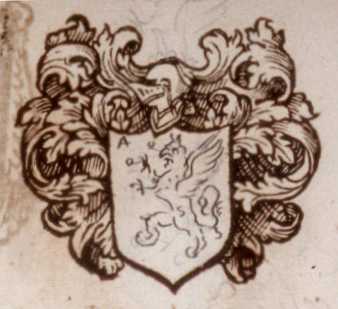
By Thomas W. Grimshaw, Austin, Texas, April 2001
The Grimshaw family originated in the County of Lancashire in the northwest part of England around 1000 A.D. There are no records of family lines, however, for the first 250 years. The earliest recorded family apparently started about 1250 A.D. at the Grimshaw location, which is about three miles southeast of central Blackburn in Lancashire.
Viking Origins of the Grimshaw Surname
Where is the Grimshaw Location?
Who Started the First Grimshaw Family?
The Grimshaw Coat of Arms
The "Grimshaw Serpent"
Where Are the Places Referenced in the Serpent Story -- Ooze Castle Wood and Griom's (or Griffin's) Ark?
The Grimshaws at Clayton-le-Moors
Early Grimshaw Family Lines in England, Ireland and Elsewhere
The Role of the Grimshaws in the Early Years of the Industrial Revolution
Other Grimshaw Connections to the Industrial Revolution
How Many Grimshaws Are There Today? Where Do The Live?
Grimshaw Immigrations to North America
Early Census Records for Grimshaws in the U.S.
Grimshaw Family Lines In North America
Some North American Grimshaw Family Lines Discovered So Far
Miscellaneous Grimshaws and Grimshaw-Related Stories
| Grimshaw: a Name with Viking Origins |
Much of the early history of England consisted of a succession of invasions of peoples from the European continent, especially the northern, Scandinavian areas. Among these invaders were the Vikings -- Norsemen who conducted raids on (and settled in) other countries, including England. Odin was one of the chief gods of the Norse. The Grimshaw name is apparently derived from a location where descendants of Viking invaders of Lancashire believed that Odin came to the earth to be among people. When Odin came, he wore a mask to hide his identity and was known as the Grimr. Grimshaw apparently originally meant "Grimr's Wood".
| Where Is the Grimshaw Location? |
There are actually two locations that were important in Grimshaw family history; both are in Lancashire. The closest major city is Blackburn. The first location is the original Grimshaw site (Grimr's Wood?) in Eccleshill Township, about three miles southeast of central Blackburn (near Darwen.) The second location is Clayton-le-Moors, which is about five miles northeast of central Blackburn.
The Grimshaw site is on a stream called Hoddleston and then Waterside Brook in its upper reaches, Grimshaw Brook in the middle portion (where the Grimshaw location is), and Davyfield Brook in the lower reaches. A picture of the Grimshaw site, taken from Belthorn on the top of Pickup Bank, is shown below.
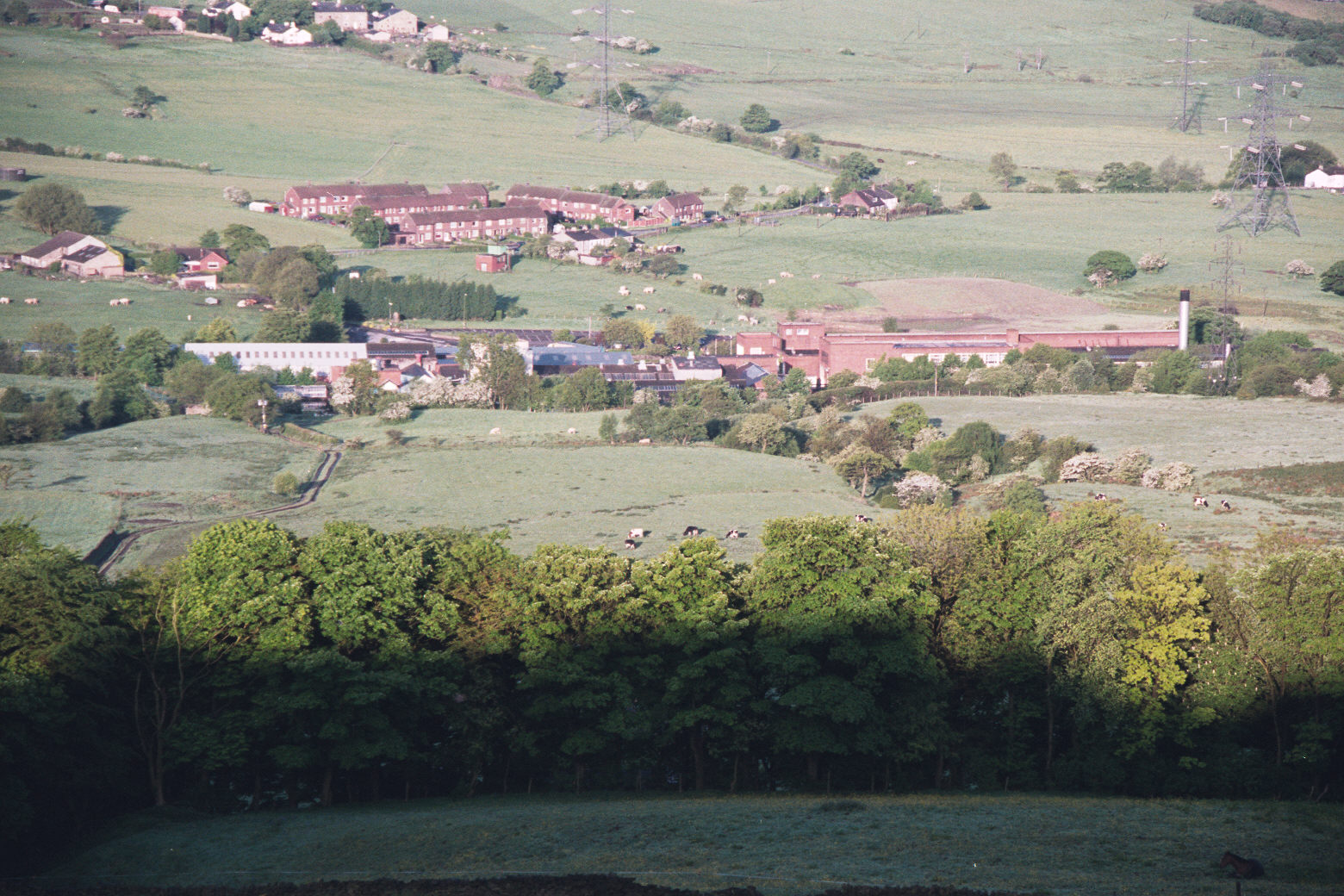
The site is now occupied by an envelope factory (Grimshaw Brook Mill) and a closed-down paper mill. Higher Grimshaw Farm is also located nearby. Pictures of the factory and a plaque at Higher Grimshaw Farm are shown below. The big roller is from the old paper mill, and the people are Grimshaw descendants.
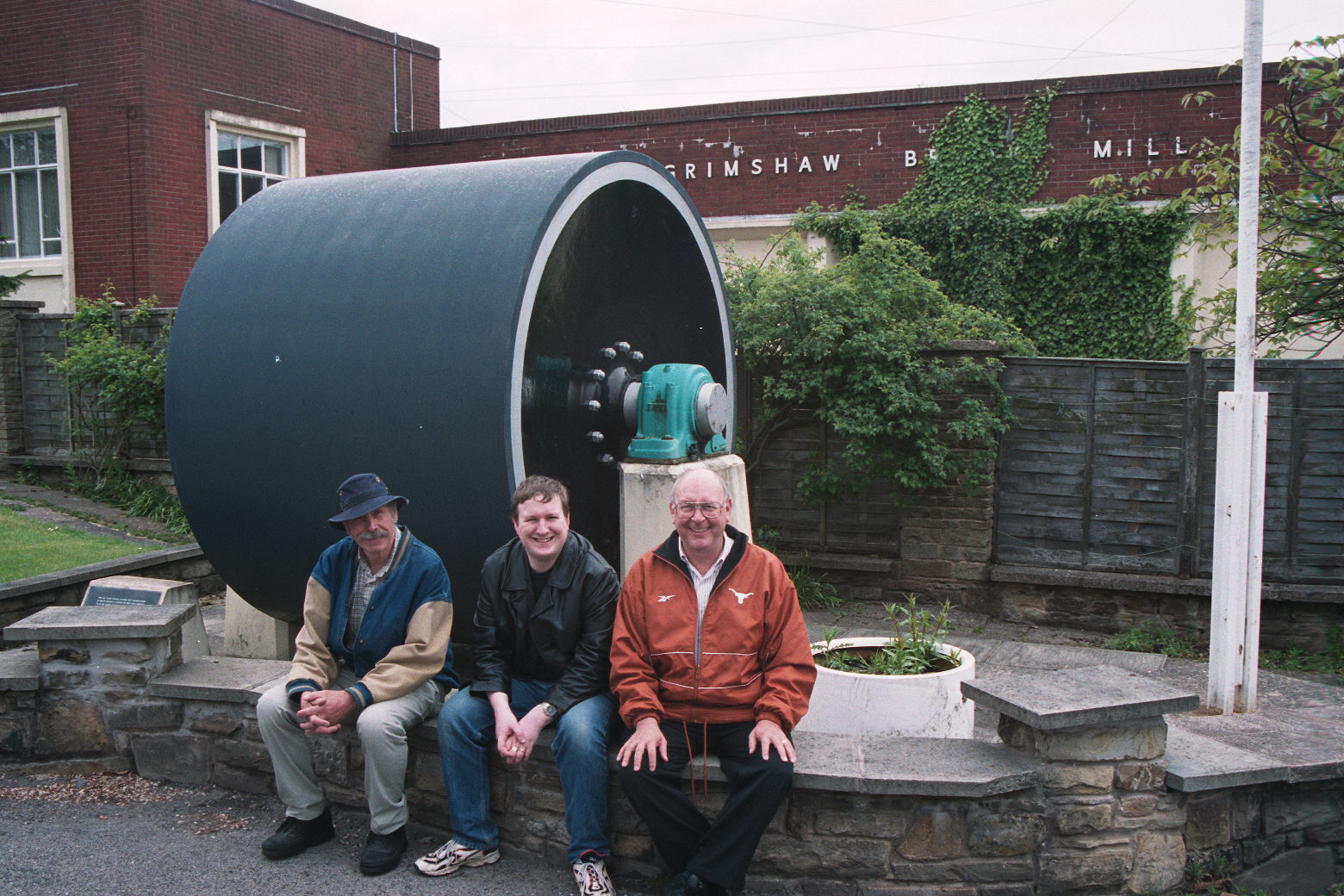
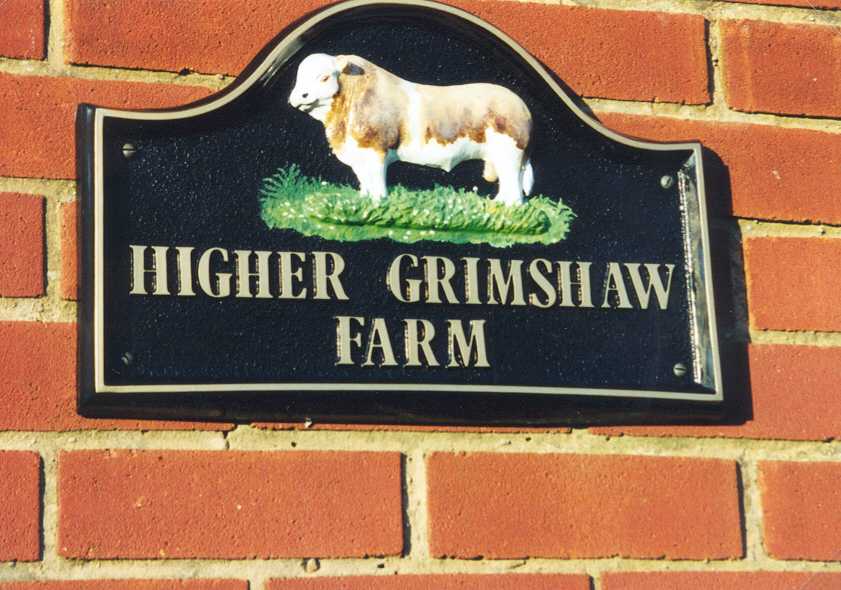
Apparently, the earliest recorded Grimshaw family lived at this Grimshaw location from its origins until the mid-1300s, when the Grimshaw family relocated to Clayton Hall in Clayton-le-Moors because of a fortuitous marriage into the Clayton family. Clayton Hall is described below.
| Who Started the First Grimshaw Family? |
The earliest Grimshaw on record was Walter, who was living in about 1250 A.D. Walter was the progenitor of most, if not all, Grimshaw lines that have survived into the present. Walter's family is closely associated with the Grimshaw location in Eccleshill. It is not known if Walter was the first Grimshaw at the location or if he was derived from a family already there. If the Grimshaw family was in existence at the time of the Norman invasion in 1066, as has been reported by some sources, the first Grimshaw on record in 1250 was derived from a family already 200 years old.
| The Grimshaws at Clayton-le-Moors |
As noted, Walter's descendants lived at the Grimshaw location in Eccleshill until about 1350, when his great-great-grandson, Adam, married Cecily Clayton. Celicy was the co-heiress of the Clayton-le-Moors estate, so the Grimshaws moved there. It is located about five miles northeast of central Blackburn (six miles northeast of the Grimshaw location in Eccleshill).
The Grimshaw family remained at Clayton Hall for 11 generations, until about 1715, when the male heirs ran out. The family had a rich history during their 350+ years at Clayton-le-Moors. They retained their Roman Catholic faith in spite of often severe anti-Catholic sentiment and actions after King Henry VIII. A picture of the modern Clayton Hall (built to replicate, at least in part, the previous Clayton Hall that was torn down in 1977) is shown below. The photo was taken northward from south side.
| The Grimshaw Coat of Arms |
The coat of arms of the earliest recorded (Walter's) Grimshaw family line at Clayton-le-Moors is dominated by a griffin, a mythological creature that is half lion and half eagle. The crest consists of two lions’ heads arranged back to back. A rendition is shown below.
During medieval times, the King dispatched his representatives (Heralds) to various parts of England to grant heraldic rights and to verify the validity of armorial bearings (coats of arms and crests) being used by various families. In many cases, family lineages were also recorded; these records therefore now comprise a valuable source of family history information. A rendition of the Grimshaw arms that was recorded during the 1567 Heraldic Visitation (by William Flower) is shown on the first page of this booklet.
| The "Grimshaw Serpent" |
An interesting folk tale related to Grimshaw family history, no doubt based at least in part on a real event, was recorded by Charles Owen in a 1742 publication. This tale relates the slaying of a large snake by a Grimshaw during medieval times. There has been some confusion about the relationship of this tale to the Grimshaw surname. Considerable confusion also exists concerning a possible connection of the serpent tale to the griffin on the Grimshaw coat of arms. The first part of Owen's article reads as follows:
I am informed by some persons, who had it by tradition from ancient people, that formerly there was in this country a monstrous serpent of four or five yards long, and thicker than a common axle-tree of a cart, and very mischievous, preying upon lambs, etc. Its chief residence was in a wood near Pickup Bank, a few miles from Blackburn in Lancashire called Ouse Castle, where there is yet a little spot of ground called Griom’s Ark, which is a deep cavern, situated among rocks in a wood, from whence it was seen to come out and bask itself on a sunny bank.
The picture of this serpent is drawn with wings, two legs, and talons like an eagle, which is in some ancient houses (and particularly at Clayton Hall near Dunkinhall) by which it appears to be very large and furious.
It is said one ____ Grimshaw, Esq., proprietor of that hall, shot the monster with arrows, and had an estate offered him for that good service done to his country, which he refused, and only desired that he might have a passage through that wood to a township he had on t’other side of it, which was granted, the title to which is found in ancient writings. By another hand I am informed, that it was supposed to be a griffin, which is a bird of prey, and of the eagle kind, which, I take to be the Ossifrage of Moses, and mentioned in Levit. xi.
This poetic griffin is frequently seen in ancient medals, and is still bore in coat-armour. The ancient and honourable family of the Guillims blazons it rampant, alleging any very fierce animal may be so blazoned as well as a lion. It is observable that in the front of Clayton Hall are two figures drawn in plaster in the form of a coat of arms: on the right side of the escutchion is a figure with wings, four feet and a tail twisted in the form of a serpent. The like figure is drawn in plaster in several ancient houses in that neighbourhood, which go under the name of the Griffin’s Picture, and the sign is used at Public Houses. There is a place in that wood called the Griffin’s Ark.
As noted, Owen's story has led some to some very understandable confusion. In essence, Owens intimates that the snake was the "grim" in Grimshaw and Ooze Castle Wood is the "shaw." This interpretation is untenable, however, because the chap who killed the snake was already named Grimshaw, and he was already living at Clayton Hall. As noted, the Grimshaws did not move to Clayton-le-Moors until the mid-1300s, when the name was probably already as much as 300 years old.
The Viking origins of the Grimshaw surname is described above. The earliest recorded family was headed by Walter de Grimshaw, who was living about 1250, 100 years before the family moved to Clayton le Moors.
Thus the "grim" in Grimshaw is derived from the Viking "Grimr" and not from the snake in Owen's article. The "shaw" in Grimshaw is not Ooze Castle Wood, but is a location where the Viking descendants thought the Grimr lurked (probably the Grimshaw location, a mile away from Ooze Castle Wood.) And the griffin in the coat of arms preceded the killing of the snake by many decades.
| Where Are the Places Referenced in the Serpent Story -- Ooze Castle Wood and Griom's (or Griffin's) Ark? |
Ooze Castle Wood is located along Means Brook, a tributary of Grimshaw Brook, about a mile southeast of the Grimshaw location. The wood now has a small dam and reservoir just below it that apparently were constructed sometime in the 1800s. A picture of Ooze Castle Wood is given below.
A brief field survey of Ooze Castle Wood in May 2000 resulted in identification of a potential candidate for Griom's Ark. It is shown in the figure below. However, it is not certain that this opening is, in reality, the original Ark as described in Owen's 1742 article.
The opening is a crevice in a sandstone block that is part of a slump (earth movement) on the bank of Means Brook.
| Early Grimshaw Family Lines in England, Ireland and Elsewhere |
As many as 35 or 40 family lines may have "spun out" from Walter Grimshaw's family line. No Grimshaws are known whose family came from other lines besides Walter's. The Oakenshaw Line of Grimshaws started from the 6th generation of the Clayton line when John Grimshaw married Elizabeth Aspden. They lived at Oakenshaw, about a mile southwest of Clayton Hall, at around 1400 A.D.
The Pendle Forest Line started from the 11th generation, by a Nicholas (living in 1418) who apparently moved to Heyhouses, on Pendle Hill. This line includes many branches that have migrated throughout England and the former colonies. Pendle Hill, shown in the figure below, is in the area where the eight so-called "Pendle witches" were were arrested. After some very questionable legal proceedings, they were hanged for witchcraft in Lancaster in 1608.
Edward and Dorothy (Raner) Grimshaw started a family line in Rawdon (near Leeds in Yorkshire) that apparently also includes many branches. This Yorkshire Line has apparently not yet been "tied back" to the more senior Eccleshill and Clayton-le-Moors line.
The Shuttleworth family was based at Gawthorpe, which is in Padiham, about four miles northeast of Clayton Hall. An early ancestor of this family is Anne Grimshaw, wife of Hugh Shuttleworth, and daughter of Thomas Grimshaw and Margaret (Harrington) Grimshaw. Anne was in the 11th generation (after Walter) of the original Grimshaw family line. She was buried at Padiham in 1597. A photo of Gawthorpe Hall is shown below.
An "Irish" line of Grimshaws began from the Pendle Forest Line when another Nicholas (six or seven generations after the Nicholas who went to Pendle Hill) emigrated and started the cotton textile industry in Ireland. The Irish line has included some of the more prominent and accomplished members of the Grimshaw family. The graves of Nicholas, his wife, Susan (Briercliffe) Grimshaw, his son (also Nicholas) and his son's wife Mary (Wrigley) Grimshaw, are marked by a beautiful Celtic cross in the cemetery at Carnmoney, near Belfast, Ireland. A photo is shown below along with a portrait of Nicholas.
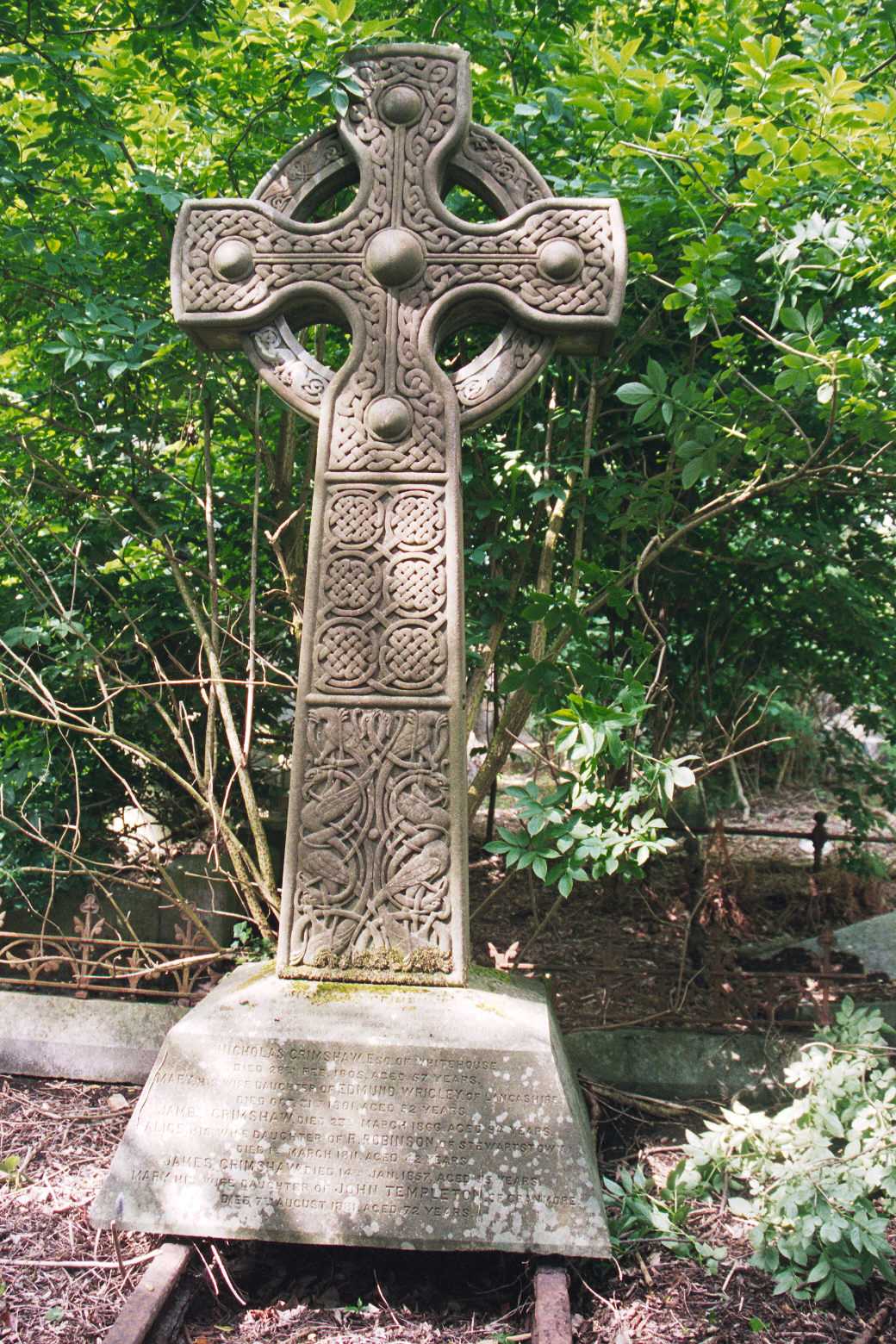
| The Role of the Grimshaws in the Early Years of the Industrial Revolution |
The Industrial Revolution has both fueled the advance of Western (and world-wide) civilization in the modern era and brought mankind to the deepening realization of the limits of the earth as well as the need to re-define our relationship to the planet. The Grimshaws were in the right place and time to be deeply involved in the origins and development of the Industrial Revolution. Many Grimshaw connections can be found in historical records, especially in textiles and coal mining, both of which became so prevalent in Lancashire.
The Industrial Revolution had a marked impact at both places where the early Grimshaw families lived. Both Eccleshill and Clayton-le-Moors were extensively mined for coal and were heavily industrialized. The Grimshaw location was the site of an early water-powered cotton mill that was later converted to a paper mill, which is still at the location but has been shut down in recent years. Clayton-le-Moors and Oakenshaw were the locations of many textile mills in the 1800s and the first half of the 1900s.
The Grimshaws were also connected to the inventors of some of the key textiles inventions and participated in the Industrial Revolution in other important ways. For example, James Hargreaves invented one of the most important devices for advancement of the production of cotton textiles in Lancashire. His spinning jenny also exemplified the kind of inventiveness that made the Industrial Revolution possible. A picture of a spinning jenny is shown below. ("Jenny" is apparently an old word for engine.")
Hargreaves married Elizabeth Grimshaw on September 10, 1740 at nearby Church Kirk, and they had 11 children from 1744 to 1767. The spinning jenny was invented while they lived at Stanhill, which is between Eccleshill and Clayton-le-Moors.
Richard Arkwright is credited with inventing the mechanical spinning machine and developing the factory system for deploying the machines. He was apparently assisted in the development of his invention by Nicholas Grimshaw, a prominent figure (mayor seven times) in Preston. Edmund Cartwright is credited with inventing the power loom and securing patents for it. Robert Grimshaw made a business arrangement with Cartwright to deploy 500 looms in a weaving mill near Manchester. Unfortunately, the factory was burned in 1790 (probably by an arsonist) not long after it went into operation, apparently the victim of the social unrest and reaction to the Industrial Revolution at the time.
| Other Grimshaw Connections to the Industrial Revolution |
Nicholas Grimshaw (described above) played a pivotal role in bringing the textile industry to Ireland during the same timeframe that members of the Grimshaw family were actively participating in the beginnings of the Industrial Revolution in England. Nicholas was from Blackburn and apparently emigrated to Ireland in about 1776. The textile industry began in Ireland when he (or his son, also Nicholas) opened the first cotton mill in 1784 at a location near Belfast.
The social ills that accompanied the Industrial Revolution included high unemployment, low wages and the lack of a social "safety net" which led to great suffering, and even starvation, among the textile workers in Lancashire. Four days of rioting ("Power Loom Riots") occurred in 1826 during which more than 1000 power looms were destroyed by desperate persons. The first day of rioting (April 26) started at Clayton-le-Moors and included eight factories. Two Grimshaw women (Alice and Ellen) were implicated in the attack on White Ash factory in Ostwaldtwistle on the first day of rioting. Also, Phoebe Tomlinson, later the wife of John Grimshaw (soldier in the Coldstream Guards), was arrested and convicted for her involvement in the rioting.
As noted above, Robert Grimshaw's mill was apparently burned 35 years earlier by an arsonist in connection with the social reactions to the dislocations brought on by the Industrial Revolution.
The Grimshaws were involved in the social unrest in other ways as well. For example, "Radical" John Grimshaw apparently was the author of two interesting poems that protested the treatment of the textile workers: "Hand Loom v Power Loom" and "The Hand Loom Weavers' Lament." The latter poem is shown below.
THE HAND-LOOM WEAVERS’ LAMENT
By John Grimshaw
(sung to "A hunting we will go")
You gentlemen and tradesmen that ride about at will
Look down on these poor people; it's enough to make you crill;
Look down on these poor people; as you ride up and down,
I think there is a God above will bring your pride quite down.
Chorus - You tyrants of England, your race say soon be run,
You may be brought unto account for what you've sorely done.
You pull down our wages, shamefully to tell;
You go into the markets, and say you cannot sell;
And when that we do ask you when these bad times will mend
You quickly give an answer, "When the wars are at an end".
When we look at our poor children, it grieves our hearts full sore,
Their clothing it is worn to rags, while we can get no more,
With little in their bellies, they to their work must go,
Whilst yours do dress as manky as monkeys in a show.
You go to church on Sundays, I'm sure it’s nought but pride,
There can be no religion where humanity’s thrown aside;
If there be a place in heaven, as there is it the Exchange,
Our poor souls must not come near there; like lost sheep they must range.
With the choicest of strong dainties your tables overspread,
With good ale and strong brandy, to make your faces red;
You call’d a set of visitors - it is your whole delight –
And you lay your heads together to sake our faces white.
You say that Bonyparty he's been the spoil of all,
And that we have good reason to pray for his downfall;
Now Bonyparty's dead and gone, and it in plainly shown
That we had bigger tyrants in Boneys of our own.
And now my lads, for to conclude. it's time to make an end;
Let's see if we can form a plan that these bad times may mend;
Then give us our old prices. as we have had before,
And we can live in happiness, and rule off the old score.
| Grimshaws Today |
Today there are apparently about 18,000 living persons with the Grimshaw surname. About 13,350 are in Great Britain, 2400 are in the U.S., 1200 are in Australia and New Zealand, 750 are in Canada, and the remainder are scattered in 10 to 12 other countries. Apparently most, if not all, of these families are descended from Walter Grimshaw and his descendants from Eccleshill in Lancashire.
| Grimshaw Immigrations to North America |
Grimshaws have been apparently been coming to America since the mid-1600s, less than 50 years after the founding of the Jamestown Colony in Virginia. It appears that more than 130 Grimshaw immigrants entered the U.S. (and the preceding colonies) between 1651 and 1880.
The earliest Grimshaw immigrants (the first dozen or so) came during the colonial period and early history of the country and appear in records related to the Virginia and Maryland colonies. They appear as owners (or at least tenants) of land, as an indentured servant (in one case), and as convicts that were deported to Virginia or Maryland. One couple is also recorded as coming to the Georgia colony. After the Revolutionary War, the immigration pattern changed dramatically and shifted northward, with the majority of records showing connections with New York, particularly as immigrants through the port of New York. Strong connections in Pennsylvania are also indicated, especially in naturalization records.
| Early Census Records for Grimshaws in the U.S. |
A survey was has been conducted for Grimshaw entries in readily available (published) census indexes. The period covered in the census survey was from before 1790 to 1860. Almost 400 indexes were examined, of which 94 were found to contain Grimshaw entries. The total number of Grimshaws included in the census data increased from 2 before 1790 to 118 in 1860. Grimshaws were found in 32 states over the 90-year period.
| Grimshaw Family Lines in North America |
A clear and consistent picture of the family lines of Grimshaws in North America is only just barely emerging. One of the main purposes of this report is to encourage interest in identifying Grimshaw family lines and to help the overall Grimshaw research effort. The American Genealogical- Biographical Index (AGBI), one of the standard references for genealogical and biographical information in America, contains 30 Grimshaw listings. These 30 Grimshaws are indexed from a total of 12 references.
The Edwin A Grimshaw Collection of American Grimshaw Family Lines. -- About 20 years ago Ed purchased a book of Grimshaw family information offered by Beatrice Bayley. In an effort to trace his family history, Ed sent inquiries to all of the nearly 600 Grimshaws listed in the book and received about 75 responses. His collection of responses, received in 1979 and 1980, comprise a valuable record of Grimshaw immigrants to the U.S. and their descendants; it is still being researched and documented.
| Some North American Grimshaw Family Lines Discovered So Far |
William Grimshaw fought in the American Revolutionary War on the side of the Colonials. He was a member of Hazen’s Regiment, which was initiated in Canada by Moses Hazen around the beginning of the conflict. Apparently William’s service began in January 1782 and continued until the regiment was disbanded in June 1783, a period of about 18 months. Records indicate that William was a fifer and that he served in (Clement or Louis) Captain Gosselin’s Company. He caused a casualty in February 1782 – a man named Musick or Musiak. After the war William received bounty land for his service, receiving Bounty Land Warrant No. 13129, dated March 25, 1790. A copy of the warrant is shown below. Also shown is a plaque on a war memorial in Bath, NH showing William's participation in the war.
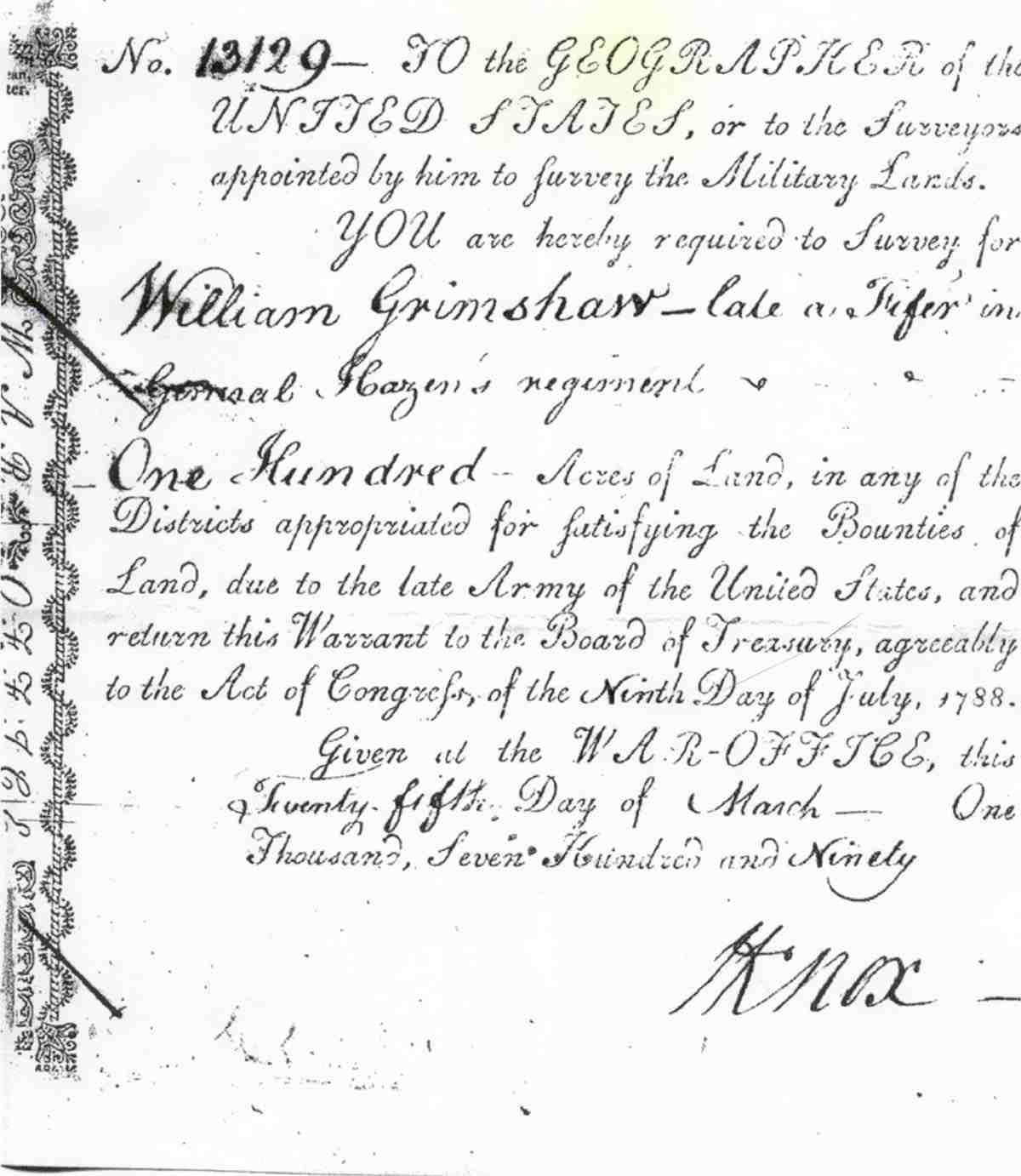
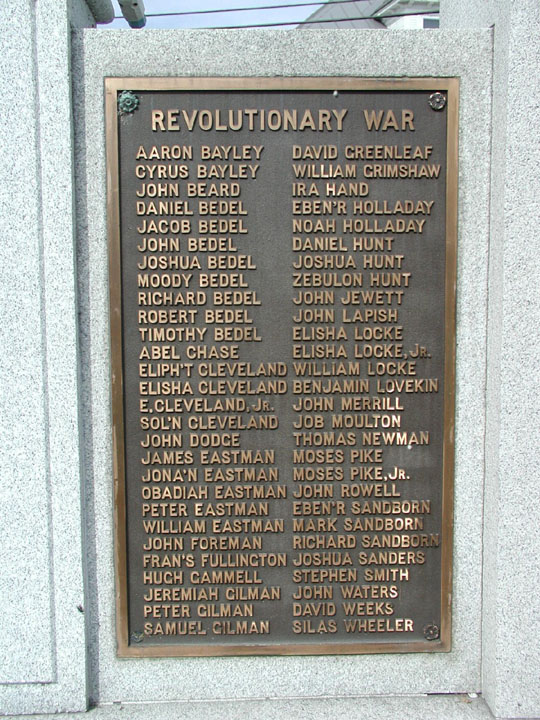
Following his Revolutionary War service, William settled in New Hampshire, where he apparently had a family and remained for more than 20 years. During that time he left at least 20 direct (and two indirect) records, including land transactions, census tallies, road petitions, marriages and intentions to marry, and inventory and tax records. The records discovered so far cover William's life in New Hampshire from about 1788 to around 1811. Indirect evidence indicates that William's wife was Elizabeth Lepninah or Zephaniah, and they had nine children (five girls and four boys.)
Zephaniah Grimshaw, believed to be the oldest son of William and Elizabeth, lived in the area of southwestern Quebec and northern New York state in the early 1800s. He was one of the most prolific Grimshaws, fathering nearly 20 children. The town of Grimshaw, Alberta, Canada is named for Matthew Grimshaw, a physician who was apparently a descendant of Zephaniah.
Two Grimshaw families lived on Wolfe Island, Ontario, which is located near Kingston at the head of the St. Lawrence River at Lake Ontario. The first Grimshaws to settle on Wolfe Island were apparently William and Mary Ann (Blair) Grimshaw, who acquired several parcels of land in the western half of the island. William is believed to be the oldest son of Zephaniah. The second family to live on Wolfe Island was that of George and Charlotte (Menard) Grimshaw. George is believed to be the second son of William and Elizabeth Grimshaw. George and Charlotte apparently had about 8 children. Many of their descendants are in the U.S., since three of their sons moved to Wisconsin.
John James and Mary Ann (Mahoney) Grimshaw apparently met and married on Wolfe Island. John was the third child (oldest son) of George and Charlotte Grimshaw. Mary Ann came from Ireland during the potato famine. After most or all of their children were born, they emigrated to the U.S. and settled in southwestern Wisconsin.
Duckworth Grimshaw converted to Mormonism in England and emigrated to Utah in about 1862. There he met his first wife, Mary Jane Moyes, and had 13 children. A noteworthy feature of Duckworth's life was his polygamous second marriage, to Ellen Muir Smith, for which he spent a year in the Utah penitentiary. The one child from the second marriage apparently left no descendants.
Duckworth was given as his first name the surname of one of his maternal ancestors. Like Grimshaw, Duckworth is a Lancashire name of long standing. Duckworth Hall is located southeast of Blackburn within a few miles of the Grimshaw location; it is shown below.
William Robinson Grimshaw, born in New York City to John Grimshaw, immigrant from Yorkshire, led an adventurous life, including time at sea on sailing vessels, and was in on the "ground floor" of the California Gold Rush of about 1848. William's adventures are chronicled in a book based on his recollections entitled "Grimshaw's Narrative." He married Sarah Pierce Rhoads and had 12 children, although many of them died young.
Eleanor Grimshaw, daughter of John and Mary Jane (Hutton) Grimshaw, married twice, to George Dixon and Harry Shenfield. She lived mostly in western Canada, where many of her descendants still reside. The coat of arms and crest of John Grimshaw are shown below.
Joseph Grimshaw, son of Abraham and Ellen (or Eleanor) (Whalley) Grimshaw, married twice, to Margaret Wetherold in England and Elizabeth Mitchell-Hadden in the U.S. He was descended from the Yorkshire Grimshaw line and apparently lived in New York in the early 1800s. He had a total of 11 children, eight with Margaret before emigrating and three with Elizabeth in the U.S.
Thomas and Helen (Brettargh) Grimshaw apparently migrated to Colbourg, Ontario and subsequently to North Carolina. Thomas, a member of the Pendle Forest line, visited the U.S. and Western Canada in 1850, during which he kept a detailed and very interesting diary which is still in existence. He then returned to England and the family subsequently emigrated to Ontario in 1852. They had six children.
William Grimshaw, Noted Historical Author was a descendant of the "Irish" Grimshaw line (described above). He immigrated to the U.S. from Ireland in 1815 and lived mostly in Philadelphia, where he became a noteworthy author of many historical textbooks and other works. William married twice and was the father of at least three other Grimshaws who established good reputations in the U.S. William Arthur was a lawyer who moved to Illinois during the pioneering days of the 1830s and was subsequently elected to the state legislature. Arthur Harper fought on the Union side in the Civil War after raising his own regiment in Delaware. Robert E. authored numerous engineering and other technical works and was a co-founder of the American Society of Mechanical Engineers.
Robert E. Grimshaw developed a distinguished career as a mechanical engineer in the late 1800s and early 1900s. He published numerous technical books and was on the faculty of New York University, City College of New York and Rutgers University. He was also a participant in the founding of the American Society of Mechanical Engineers. One of Robert's many books was "Fifty Years Hence, or What May Be in 1943," a quasi-fictional work with the evident intent of making a sincere effort to predict the future. Robert dedicated the book to his children, "Who may perchance, fifty years hence, compare these prophecies with what has then come about." But Robert apparently lived long enough (to at least 1940) to make the comparison for himself! The interesting icon from the cover of "Fifty Years Hence" is shown below along with a photo of Robert.
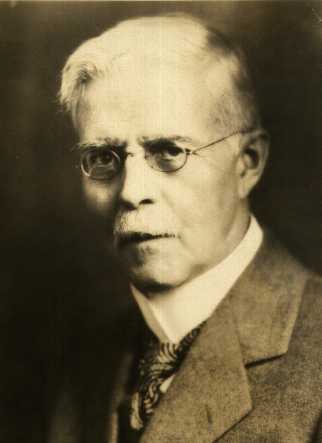
| Miscellaneous Grimshaws and Grimshaw-Related Stories |
One of the most noted and successful of the Grimshaws in their native Lancashire was Nicholas Grimshaw, a member of the Pendle Forest line who served as Preston mayor seven times. His noteworthy political career spanned more than 40 years, from 1790 to 1832, and included two Guild mayoralties. A portrait of Nicholas is shown in the figure below.
William Grimshaw of Haworth was deeply involved in the evangelical movement in England in the early 1700s. He was educated for ministry in the Church of England. During his tenure as head of the church in Haworth, he became a strong evangelist and worked closely with the Wesley brothers during the era when the Methodist church was founded. William did not sever his ties with the Church of England, but he preached in many parishes outside his own and gained a significant reputation for the power of his sermons and the large number of conversions to evangelical Christianity for which he was responsible. A portrait of William and a picture of the church in Haworth as it appears today are shown below.
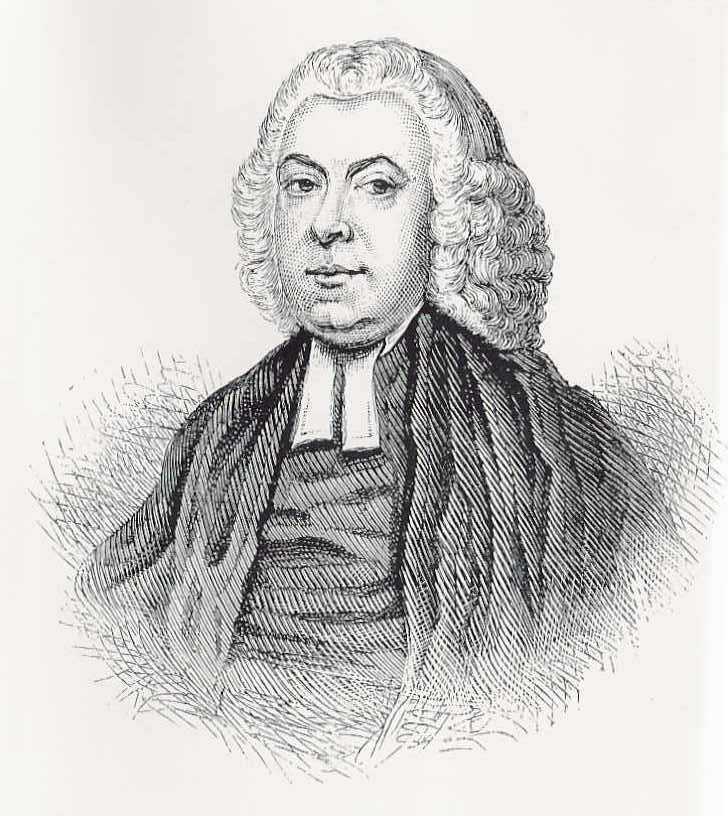

William was born in Brindle in Lancashire County. Apparently, his family has not yet been "connected" to the original Grimshaw family tree. At least four books have been written about William's life, the most recent published in 1997.
Thomas Shuttleworth Grimshawe was one of the more accomplished members of the Pendle Forest line of Grimshaws. He held two positions simultaneously in the Church of England and was author of several works, including two notable literary pieces – Memoirs of the Rev. Legh Richmond and The Works of William Cowper. The latter work was published in eight volumes, each of which has one or two beautiful engravings near the title page depicting significant people and places in Cowper's life. Engravings of Cowper's mother and his home in Weston are shown in the following figures.
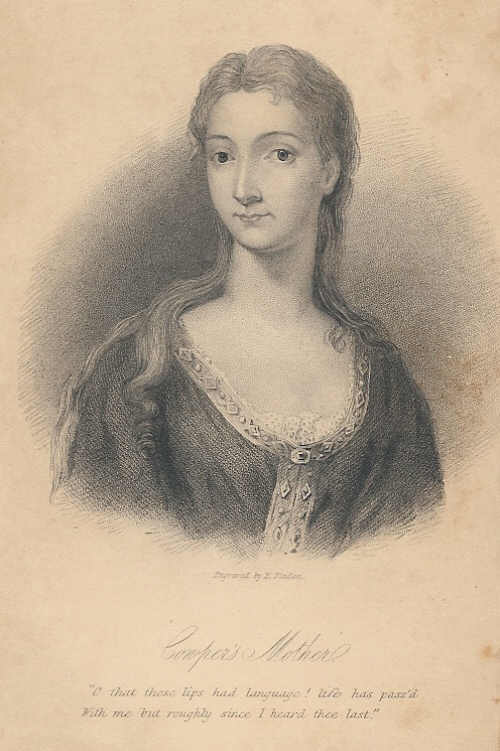
In 1906, Francis John Angus Skeet published a history of several families that included a line of Grimshaws from Audenshaw in England. The original Grimshaw family line from Whitaker is also presented in summary form to provide context. This reference usually emerges for Grimshaw researchers who are just getting started because of the presence of the Grimshaw name in the title. However, very little information beyond the Audenshaw family line is provided on the Grimshaws, and no connection is made of the line back to the original family line.
John Grimshaw is an interesting representative of the Lancashire Grimshaws from two standpoints -– his army career in the Coldstream Guards, one of the most distinguished military units in England, and his participation in the textile industry before and after his 12-year military career. John Grimshaw was born in 1789; his connections to the original Grimshaw line are not known. He enlisted in the Coldstream Guards in 1806 and fought at the Battle of Waterloo on June 18, 1815, where he was wounded in jaw and hip while engaged in the defense of the chateau of Hougoumont. The capstar emblem of the Coldstream Guards, and a modern photo of the Coldstream Guards with the Queen at Windsor Castle or Buckingham Palace, are shown below.
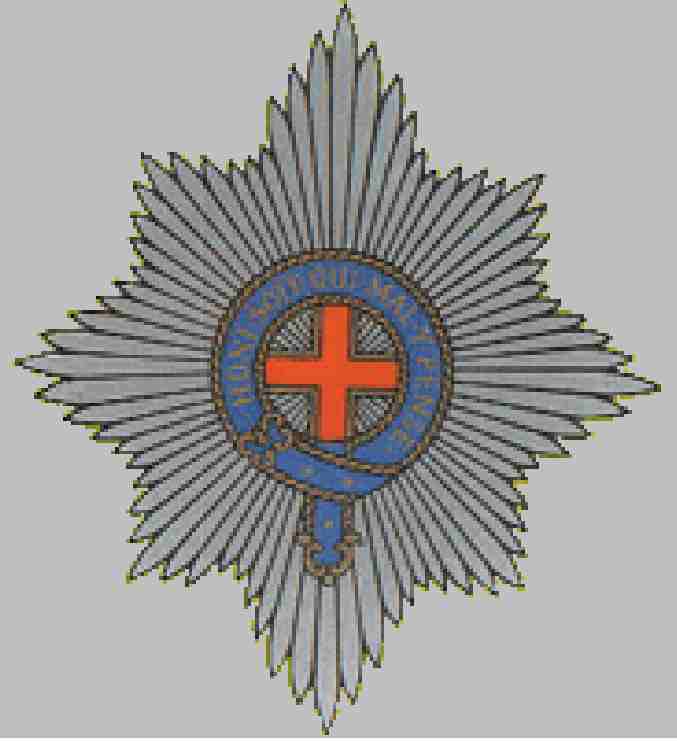
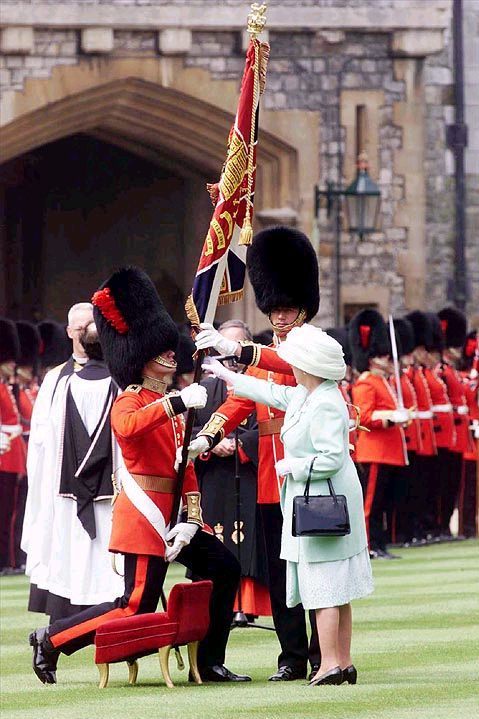
After discharge, John Grimshaw returned to his home in Lancashire as a weaver and was (possibly) one of the rioters who on April 24-26, 1826 attacked local factories where new steam-powered looms were installed. These looms were seen as a threat to the livelihoods of hand-loom weavers. One of the rioters was Phoebe Tomlinson (mentioned above), John's future wife, who was sentenced in August 1826 at Lancaster Assizes to 12 months imprisonment in Preston gaol for her part in the riots.
Norman Poulton published a novel in 1896 entitled "Moses Grimshaw – a Story of Lancashire Life". His apparent purpose in the book was to expound upon his social and ethical values and theories, using a fictional "idealized" Lancastrian as the vehicle, in the context of late Victorian England at the peak of the Industrial Revolution. What is perhaps most significant to Grimshaw family researchers is Poulton's choice of the surname "Grimshaw" as being representative or emblematic of Lancashire for his exposition.
The Griffin was a brig that operated out of Liverpool in the 1770s under the command of a Captain Grimshaw. In 1779, the ship was recorded in Lloyd’s Register, a book of information on ships calling at English ports. Records indicate that the Griffin, acting as a privateer, successfully captured a ship, the Le Count St. Germaine, in February 1779. Another record fourteen years earlier (1764), indicates that a Grimshaw was involved in the maritime slave trade. It is not known if he is the same person as the Griffin's captain. It may be safe to assume that Griffin's Captain Grimshaw named his ship for the Grimshaw family icon. As noted above, the griffin has been associated with the Grimshaw family (on its coat of arms) going back at least to the early 1600s, and possibly as early as the 1300s. A photo of a restored brig, the U.S. Niagara, is shown in the figure below to show what The Griffin most likely looked like.
The Sinking of the Caleb Grimshaw, Emigrant Ship, in 1849. -- One of the lines of Grimshaws located in Liverpool and became involved in transatlantic shipping during the first half of the 19th century. Caleb Grimshaw apparently lived in Liverpool and operated "packet ships" between there and New York City as part of the "Black Star" line of packets. In 1849, one of his ships, apparently named for him, caught fire during the initial stages of its voyage from Liverpool to New York with 457 people on board. After several days, the Caleb Grimshaw sank near the Azores with the loss of 90 lives. Most of the others were rescued by another ship, the Sarah, that fortunately appeared on the fourth day of the fire and transported all the passengers it could hold to Flores in the Azores. An advertisement announcing the sailing of the ship ran in the Liverpool Mercury on October 19, 1849 and is shown below. Also shown is a picture of the Huguenot, a ship that was very similar in size and construction to the Caleb Grimshaw.
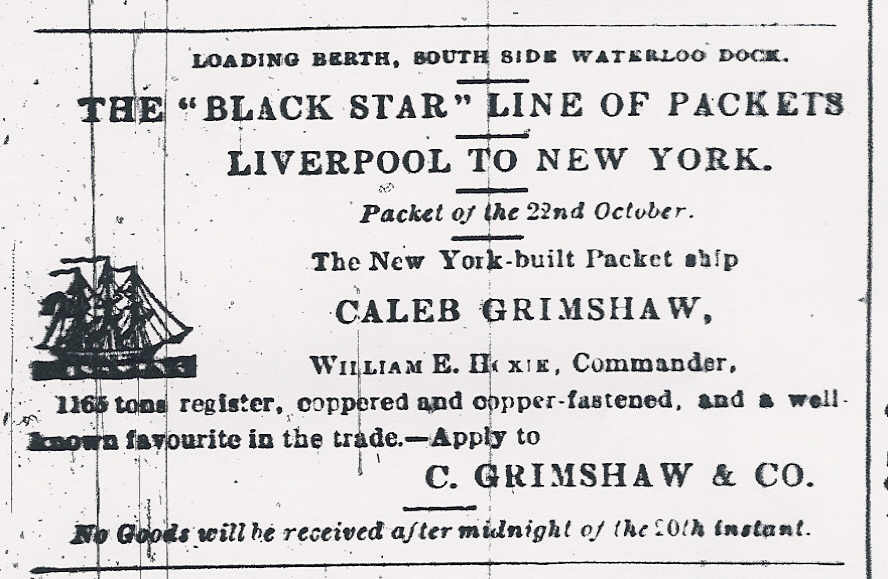
On December 4, 1849, The Liverpool Mercury carried the following report on the event. Unfortunately, the article was erroneous in its report that there were no casualties.
AN EMIGRANT SHIP ON FIRE. MIRACULOUS ESCAPE OF FOUR HUNDRED PERSONS.
The West India mail steamer, brings an account of the total loss of the emigrant ship Caleb Grimshaw, bound from Liverpool to New York, Captain Hoxie, by fire, sixteen miles S.E. of the island of Flores, one of the Azores. The emigrants, 300 in number, with the crew, were providentially saved from destruction. The cry of "fire" was raised at about eight o'clock on the night of the 12th ult. The decks were immediately flooded. On raising one of the fore hatches, the fire was discovered abreast of the chain locker. The heat was so intense that no one could live below, and the immense quantities of water poured into the ship by the crew and passengers generated steam, and the heat at length became insufferable. But this was the only means by which the ship was kept from being rapidly consumed. The boats were towed astern of the burning vessel for five days and nights, filled with poor emigrants bewailing their fate, while about sixty were on a raft, when a ship was seen bearing towards them, and which proved to be the barque Sarah, Captain Cook, bound from London to New Brunswick, in ballast. As soon as the captain of the Sarah saw the signal of distress, he immediately approached the Caleb Grimshaw, but was only able to get on board, during the night of the 17th three boatsful of passengers owing to the wind blowing hard. The next day, the 18th, he got on board about 150 passengers. Night approaching, and the wind still increasing, he was obliged to lay to. On the 19th there was a heavy sea, and no more could be got off. On the 20th, about ten persons, who had escaped from the burning ship, volunteered to return and relieve those who were on board at work, as by this time there was no more water or provisions to be got without raising the hatches. The mainmast was now settling down, and the upper deck was working each way. On this day the ship floated to the leeward of Flores into smooth water, and during the night all the passengers that remained on board got off. Before the last of the crew left, they lifted the hatches, and immediately the ship burst into a terrific blaze. The escape of all the persons, 309 in number, was almost miraculous. Consider a ship, filled with nearly 400 persons, on fire for eight days and nights, and not a single person lost his life. Nothing but the continual flooding the ship prevented her from being burnt to the water's edge, and every soul on board perishing before relief could be had. The men and crew worked like heroes.
The conduct of the master of the Sarah was beyond all praise. For three days and nights did he hover about the burning ship amidst the most tempestuous weather, taking every opportunity to lower his boats to save some of the passengers. Nothing could exceed his heroism and humanity. To him, under Divine Providence, the unhappy emigrants owe their preservation. Although perpetually obliged by the tempestuous wind and heavy sea to leave them apparently to a dreadful fate, he always endeavoured keep in sight, and cheer their aching hearts with a prospect of escape. The Sarah arrived at Fayal with the crew and passengers of the Caleb Grimshaw in safety. The passengers had lost everything on board, and were perfectly destitute, for they had the greatest difficulty to get food from the burning ship to keep them alive. Captain Hoxie chartered the Sarah to take on the passengers to New York. The Sarah had not left Fayal when the West India steamer took her departure, but the American consul was using the most strenuous efforts to arrange everything for her leaving. The Caleb Grimshaw belonged to Messrs. Grimshaw, of Liverpool. The origin of the fire was not known. [The Liverpool Mercury, December 4, 1849 (v. 39, no. 2147), p. 1]
Thomas Wrigley Grimshaw, a descendant in the "Irish" Grimshaw line, was educated as a physician in Dublin and practiced in that city until 1879, when he was appointed as Registrar-General for Ireland. During his years of medical practice, he investigated the causes and distribution of water-borne diseases in Dublin and authored a pioneering public health paper in 1872. He was honored at the initiative of his great-grandson, Nicholas Grimshaw (architect in London) in 1999, when a plaque was placed at Thomas' former home in Dublin. A photo of the plaque, at 13 Molesworth Street, is shown below with a photo of Thomas.
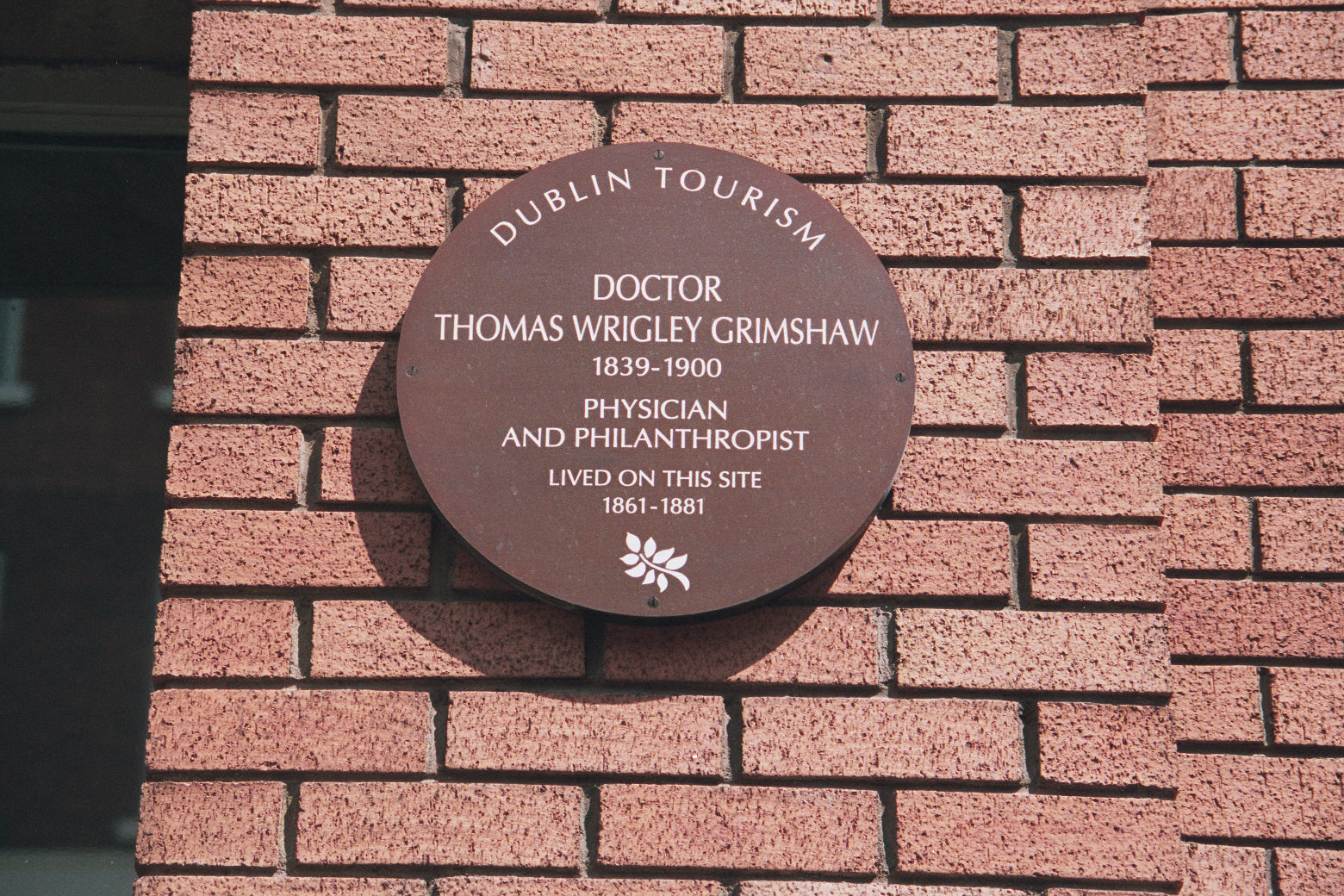
Beatrice Ethel Grimshaw achieved considerable prominence in the first half of the 1900s for her travels in the South Pacific, her non-fictional travel books on that area, and her novels set in exotic tropical locations. Beatrice was the great-granddaughter of Nicholas and Mary (Wrigley) Grimshaw, the progenitors of the "Irish" line of Grimshaws. She was born in Cloona, County Antrim, Ireland on February 3, 1870 and began her South Pacific sojourns in 1904. She died on June 30, 1953 at Bathurst, New South Wales, Australia. A photo from one of her works, From Fiji to the Cannibal Islands ("Drying Vanilla") is shown below. The woman pictured is almost certainly Beatrice, since she was the only white woman on Fiji. A portrait photo of Beatrice is also shown.
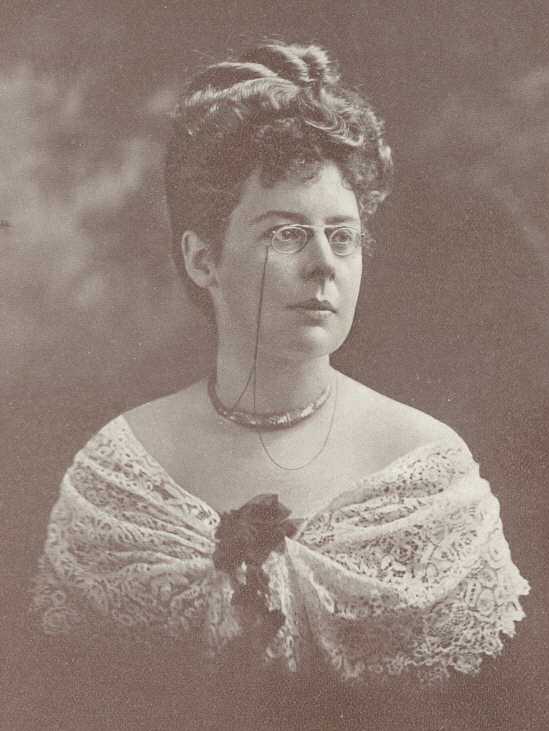
Roland William Wrigley ("Roly") Grimshaw was an officer in the Indian Army Corps of the British forces during World War I. From August 1914 to June 1915 he kept a detailed diary, subsequently published1, of his wartime experiences. Sometime during his service, a photo (shown below) was made of Roly in full uniform as a member of the Poona Horse regiment. The published diary included a number of artistic renditions of World War I battle conditions, one of which is also shown below - .
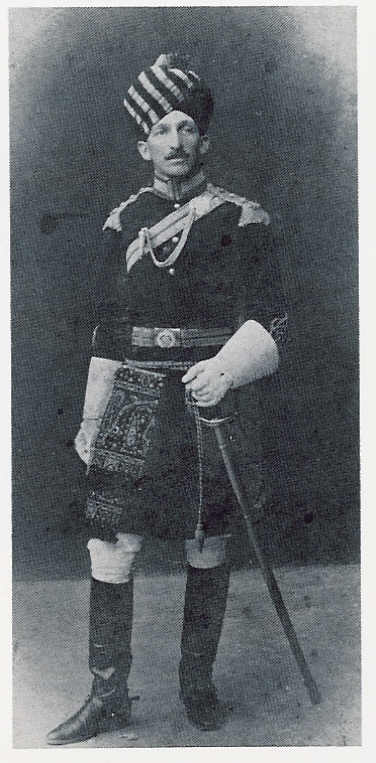
| Summary |
The Grimshaw family has had a very interesting history going back to the origins of its name among descendants of the Vikings in England. After being located in Eccleshill southeast of Blackburn for many decades (perhaps hundreds of years), the family relocated to Clayton-le-Moors through a fortuitous marriage in the mid-1300s. This original Grimshaw line resided there, in Clayton Hall, for over 350 years before the male heirs "ran out." During this period, the fascinating folk tale of the "Grimshaw Serpent" emerged.
Many junior Grimshaw family lines "spun out" from the earliest recorded line at Eccleshill and Clayton-le-Moors. Two of the earliest lines settled in nearby Oakenshaw and in Pendle Forest, several miles north of Clayton-le-Moors. Another early line emerged on the other side of the Pennines in Yorkshire.
One of the most significant aspects of this family's history was the deep involvement of Grimshaws in the origins and development of the Industrial Revolution. Many Grimshaws were personally involved both in coal mining and in industrial development. And close ties have been identified with other key figures, such as inventors. Grimshaws were also participants in the social unrest that accompanied the Industrial Revolution.
Today there are approximately 18,000 persons in the world with the Grimshaw surname. Family lines have developed from emigrants to most of the countries of the former British Empire. Notable Grimshaws in history have included politicians (including a mayor of Preston seven times), clergymen, authors, physicians, historians, soldiers, lawyers and engineers. The Grimshaws also developed a significant maritime presence, as evidenced by the privateer brig, The Griffin, with a Captain Grimshaw, in the 1700s and by the Caleb Grimshaw, an emigrant ship that sank in 1849 with the loss of 90 lives.
| Acknowledgements |
This booklet is drawn from a companion website at http://www.grimshaworigin.org. No attempt is made in the limited space available to give the many acknowledgements that are necessary, especially for the images and photos. However, full credits are given in the website. The author is very grateful to the many contributors to the website and to this booklet.